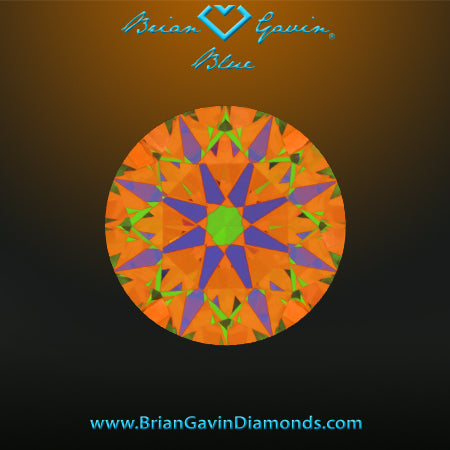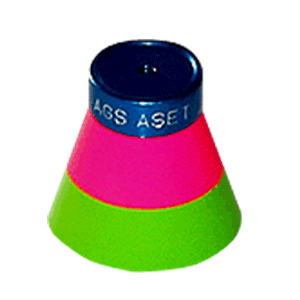
Blue vs red in ASET images
“I’m considering this 1.046 carat, G-color, VS-1 clarity, Brian Gavin Signature round diamond that exhibits very strong blue fluorescence, and am wondering about the balance of blue vs red in ASET image, because this one appears to exhibit a lot more red than green or blue and I’m not sure whether that is a good or a bad thing. I’m also concerned about the spot of green that appears in the middle of the table facet in the ASET image. I’ve also read some conflicting advice pertaining to the effect of very strong blue fluorescence on the visual properties of a diamond. Can you tell me whether the very strong blue fluorescence in this diamond makes it appear cloudy, milky or is having any sort of impact, positive or negative.”
What the colors of an ASET represent:
The ASET scope uses the colors, red, green, and blue to represent light that is entering the diamond from different positions within a chamber that is designed to mimic the lighting environment of the earth’s hemisphere.
The color red represents light that strikes the surface of the diamond from perpendicular with the table facet, up to forty five degrees, which happens to be the brightest light in the room! Thus it is a good thing when the ASET image shows a lot of red, because that means that the diamond is picking up the brightest light available within the room, and reflecting it back up towards you.
The color green represents light which is the second brightest light source in the room, which is light that strikes the diamond from forty five degrees out to the edge of the horizon. It is important to understand that green represents light being reflected from the second brightest light source, it is still extremely bright, and is not considered a negative factor unless the majority of the light being reflected is green, it should be a trace element of sorts.
 Note that since light entering the diamond is split in the ASET scope at the forty five degree mark, because of the way the scope is structured, as pictured to the left; that light entering the diamond at forty five degrees can be represented by the colors red or green, which is why the center spot of the table facet might be red, green, or a mix of the two colors.
Note that since light entering the diamond is split in the ASET scope at the forty five degree mark, because of the way the scope is structured, as pictured to the left; that light entering the diamond at forty five degrees can be represented by the colors red or green, which is why the center spot of the table facet might be red, green, or a mix of the two colors.
The color blue represents the contrast created by your head blocking light from entering the diamond, and the shadow of your head reflecting off of the pavilion main facets.
With this in mind, you should look for a diamond that exhibits a lot of red that is evenly distributed with some green, and the arrows pattern of the diamond that is created by the pavilion main facets should be blue, as is typical of Brian Gavin Signature round diamonds, which are optimized to deliver the highest volume of light return and sparkle factor.
Very strong blue fluorescence in G-color diamond:
I personally happen to be a big fan of diamonds that exhibit higher levels of blue fluorescence, thus I think that the 1.046 carat, G-color, VS-1 clarity, Brian Gavin Signature round diamond is a great find, and I don’t see any negative influence from the presence of very strong fluorescence. If anything, the very strong blue fluorescence is helping to boost my perception of diamond color, by helping to filter out any yellow undertones, which may be present in all diamonds, even those that are D-color.




















